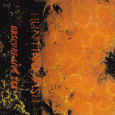HUNTING ASH: Deathtrance Parable (Obscure Live Sex, 2024)
Kao jedno od prvih djela u kompilaciji vizuelnih radova uvrstio sam ovo umjetničko djelo, William T. Williams, Elbert Jackson L.A.M.F. Part II, 1969. Ono rekonstruiše jednu od tendencija apstraktne umjetnosti koja u svojem imperijalističkom dojmu ima široku definiciju. Ona se ne podudara sa uzajamnim trenutkom življenja te gotovo djeluje kao da on i ne postoji. Dodir sa ličnim likovnim istraživanjima postoji samo u mojim djelima tokom studija. Premještanje iskustva ima uporište u nedostatku adekvatne teorije ili teoretisanja na tu temu. Citiraću jedno koje se odnosi na moguće postojanje teorije o tome.
![[ ]](fotke/mjuzik/20240427_085010_43.gif) www.moma.org/collection/works/80477
www.moma.org/collection/works/80477
Lenin, FINANCE CAPITAL AND THE FINANCIAL OLIGARCHY:
"A steadily increasing proportion of capital in industry," writes Hilferding, "ceases to belong to the industrialists who employ it. They obtain the use of it only through the medium of the banks which, in relation to them, represent the owners of the capital. On the other hand, the bank is forced to sink an increasing share of its funds in industry. Thus, to an ever greater degree the banker is being transformed into an industrial capitalist. This bank capital, i.e., capital in money form, which is thus actually transformed into industrial capital, I call 'finance capital'." "Finance capital is capital controlled by banks and employed by industrialists."[1]
This definition is incomplete insofar as it is silent on one extremely important fact—on the increase of concentration of production and of capital to such an extent that concentration is leading, and has led, to monopoly. But throughout the whole of his work, and particularly in the two chapters preceding the one from which this definition is taken, Hilferding stresses the part played by capitalist monopolies.
The concentration of production; the monopolies arising therefrom; the merging or coalescence of the banks with industry—such is the history of the rise of finance capital and such is the content of that concept.
We now have to describe how, under the general conditions of commodity production and private property, the "business operations" of capitalist monopolies inevitably lead to the domination of a financial oligarchy. It should be noted that German—and not only German—bourgeois scholars, like Riesser, Schulze-Gaevernitz, Liefmann and others, are all apologists of imperialism and of finance capital. Instead of revealing the "mechanics" of the formation of an oligarchy, its methods, the size of its revenues "impeccable and peccable," its connections with parliaments etc., etc., they obscure or gloss over them. They evade these "vexed questions" by pompous and vague phrases, appeals to the "sense of responsibility" of bank directors, by praising "the sense of duty" of Prussian officials, giving serious study to the petty details of absolutely ridiculous parliamentary bills for the "supervision" and "regulation" of monopolies, playing spillikins with theories, like, for example, the following "scholarly" definition, arrived at by Professor Liefmann: "Commerce is an occupation having for its object the collection, storage and supply of goods."[2] (The Professor's bold-face italics.) . . . From this it would follow that commerce existed in the time of primitive man, who knew nothing about exchange, and that it will exist under socialism!
But the monstrous facts concerning the monstrous rule of the financial oligarchy are so glaring that in all capitalist countries, in America, France and Germany, a whole literature has sprung up, written from the bourgeois point of view, but which, nevertheless, gives a fairly truthful picture and criticism—petty-bourgeois, naturally—of this oligarchy".
Dekonstrukcija pravca, mogućeg pojma "pravac u likovnoj umjetnosti", može se smjestiti u okviru prostora, prostornosti. Materijalizacija koja vibrira izmedju svega što možemo misliti kada nam je na umu riječ artwork. Mislim da ovo djelo ima u naslovu, kao moguću inspiraciju, umjetnika ilustratora. Umjetnik je odlično sažeo pojam boje i materijalizacije, uveo je u strogoću umjetnosti, slikarstvo u punom značenju.
Ono što dominira u okvirima ovog djela je analitička studija, crtež, umjetnička, likovna kompozicija koja odstupa od dimenzionalnosti, dimenzionalnosti koja postoji u likovnim djelima kao nešto što privlači posmatrače, dio određenog iskustva koje je dimenzionalno, doživljaj koji umjetnik u tom određenom trenutku prepoznaje kao nužnost stvaranja.
Krečovana smrča u pozadini, sloj koji ispunjava format, utisak umbre u vrijednostima nijanse koja djeluje pri prvom pogledu. Ostale boje su u komplementarnom odnosu sa linijskim ograničenjima i ne djeluju u pravcu ekspanzije, već suprotno.
Pokušaj pomjeranja kompozicije u nekim svojim ličnim istraživanjima djeluje kao dejstvo nesvjesnog. Djeluje suprematistički, te mozemo pristupiti i tumačenju slojevito, po boji. Možda to nije slučaj sa djelom David Hockney - Camera Works, u odnosima, upotrebi boje sve je isto, čini se da je to jedno isto umjetničko razmišljanje, kao da je nastalo medjusobnim uticajem, s tim sto su boje definisane drugačije, čista umbra u pozadini koja nema taj relativni izgled.
Kao prilog razmišljanu ostavljam kopiju adrese na kojoj možete čuti jedno moje izdanje, thechurchofnoisygoat.bandcamp.com/album/kre-ovana-smr-a-nocturnal.
www.botterweg.com/tabid/234/lotid/29831/Lot-29831.aspx?language=en-US
Rekao bih da taj odnos krečovana smrča - umbra pripada procesu litografije.
www.artsy.net/artwork/robert-rauschenberg-blues
U ranijem pominjanju umjetničkih djela dominira umbra. Kad je riječ o sijeni treba pomenuti Anti-100 Years of Cinema Manifesto By Jonas Mekas.
incite-online.net/jonasmekas.html
Naslovi:
1.Side A - Deathtrance Parable 15:18
2.Side B - Deathtrance Parable 12:11
![[ ]](fotke/mjuzik/20240427_085010_43.gif)
Lenin, FINANCE CAPITAL AND THE FINANCIAL OLIGARCHY:
"A steadily increasing proportion of capital in industry," writes Hilferding, "ceases to belong to the industrialists who employ it. They obtain the use of it only through the medium of the banks which, in relation to them, represent the owners of the capital. On the other hand, the bank is forced to sink an increasing share of its funds in industry. Thus, to an ever greater degree the banker is being transformed into an industrial capitalist. This bank capital, i.e., capital in money form, which is thus actually transformed into industrial capital, I call 'finance capital'." "Finance capital is capital controlled by banks and employed by industrialists."[1]
This definition is incomplete insofar as it is silent on one extremely important fact—on the increase of concentration of production and of capital to such an extent that concentration is leading, and has led, to monopoly. But throughout the whole of his work, and particularly in the two chapters preceding the one from which this definition is taken, Hilferding stresses the part played by capitalist monopolies.
The concentration of production; the monopolies arising therefrom; the merging or coalescence of the banks with industry—such is the history of the rise of finance capital and such is the content of that concept.
We now have to describe how, under the general conditions of commodity production and private property, the "business operations" of capitalist monopolies inevitably lead to the domination of a financial oligarchy. It should be noted that German—and not only German—bourgeois scholars, like Riesser, Schulze-Gaevernitz, Liefmann and others, are all apologists of imperialism and of finance capital. Instead of revealing the "mechanics" of the formation of an oligarchy, its methods, the size of its revenues "impeccable and peccable," its connections with parliaments etc., etc., they obscure or gloss over them. They evade these "vexed questions" by pompous and vague phrases, appeals to the "sense of responsibility" of bank directors, by praising "the sense of duty" of Prussian officials, giving serious study to the petty details of absolutely ridiculous parliamentary bills for the "supervision" and "regulation" of monopolies, playing spillikins with theories, like, for example, the following "scholarly" definition, arrived at by Professor Liefmann: "Commerce is an occupation having for its object the collection, storage and supply of goods."[2] (The Professor's bold-face italics.) . . . From this it would follow that commerce existed in the time of primitive man, who knew nothing about exchange, and that it will exist under socialism!
But the monstrous facts concerning the monstrous rule of the financial oligarchy are so glaring that in all capitalist countries, in America, France and Germany, a whole literature has sprung up, written from the bourgeois point of view, but which, nevertheless, gives a fairly truthful picture and criticism—petty-bourgeois, naturally—of this oligarchy".
Dekonstrukcija pravca, mogućeg pojma "pravac u likovnoj umjetnosti", može se smjestiti u okviru prostora, prostornosti. Materijalizacija koja vibrira izmedju svega što možemo misliti kada nam je na umu riječ artwork. Mislim da ovo djelo ima u naslovu, kao moguću inspiraciju, umjetnika ilustratora. Umjetnik je odlično sažeo pojam boje i materijalizacije, uveo je u strogoću umjetnosti, slikarstvo u punom značenju.
Ono što dominira u okvirima ovog djela je analitička studija, crtež, umjetnička, likovna kompozicija koja odstupa od dimenzionalnosti, dimenzionalnosti koja postoji u likovnim djelima kao nešto što privlači posmatrače, dio određenog iskustva koje je dimenzionalno, doživljaj koji umjetnik u tom određenom trenutku prepoznaje kao nužnost stvaranja.
Krečovana smrča u pozadini, sloj koji ispunjava format, utisak umbre u vrijednostima nijanse koja djeluje pri prvom pogledu. Ostale boje su u komplementarnom odnosu sa linijskim ograničenjima i ne djeluju u pravcu ekspanzije, već suprotno.
Pokušaj pomjeranja kompozicije u nekim svojim ličnim istraživanjima djeluje kao dejstvo nesvjesnog. Djeluje suprematistički, te mozemo pristupiti i tumačenju slojevito, po boji. Možda to nije slučaj sa djelom David Hockney - Camera Works, u odnosima, upotrebi boje sve je isto, čini se da je to jedno isto umjetničko razmišljanje, kao da je nastalo medjusobnim uticajem, s tim sto su boje definisane drugačije, čista umbra u pozadini koja nema taj relativni izgled.
Kao prilog razmišljanu ostavljam kopiju adrese na kojoj možete čuti jedno moje izdanje, thechurchofnoisygoat.bandcamp.com/album/kre-ovana-smr-a-nocturnal.
www.botterweg.com/tabid/234/lotid/29831/Lot-29831.aspx?language=en-US
Rekao bih da taj odnos krečovana smrča - umbra pripada procesu litografije.
www.artsy.net/artwork/robert-rauschenberg-blues
U ranijem pominjanju umjetničkih djela dominira umbra. Kad je riječ o sijeni treba pomenuti Anti-100 Years of Cinema Manifesto By Jonas Mekas.
incite-online.net/jonasmekas.html
Naslovi:
1.Side A - Deathtrance Parable 15:18
2.Side B - Deathtrance Parable 12:11
ocjena albuma [1-10]: 9
edo žuđelović // 26/04/2024
> mjuzik [last wanz]
> chek us aut!
> diskografija
> linkz
> last [10] @ terapija.net
- [njuz] Marinirana i rasplesana čestitka od riječke MARINADE!
- [njuz] SOHODOLLS, povratak zaboravljenih londonskih electro-punkera
- [njuz] PIERRE GERARD o žutom cilindru
- [njuz] VLATKO KLARIĆ svima čestita Božić i Novu Godinu!
- [njuz] 4AGAPE upućuju raspjevanu čestitku svim pratiteljima Terapije!
- [njuz] LEZET na Božić objavio album "Christmas 2"
- [njuz] HANNA LEE, neobičan debi album "textures" iz Bogote (Kolumbija)
- [njuz] Sve najbolje želi vam Pozitivan ritam!
- [njuz] MASAYA KATO - "Glass Anthimeria" na LINE etiketi
- [njuz] MANJA RISTIĆ - "Into Your Eyes"
well hosted by plus.hr |
web by plastikfantastik*





